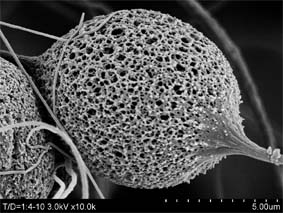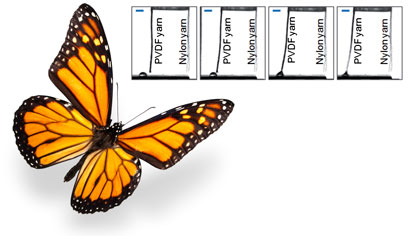Scientists from China have created nanoparticles with dual mode colour for anti-counterfeiting ink, making it harder to imitate than current inks.
Lehui Lu and colleagues from the Chinese Academy of Sciences, Changchun, have designed dual mode fluorescent lanthanide doped nanocrystals to make the ink. The nanocrystals display upconversion, in which particles absorb light of one wavelength and emit light of a shorter wavelength, and downconversion, in which a high energy photon is split into two lower energy photons. These are triggered by near infrared and ultraviolet light, respectively, to produce different colours. The crystals would make the ink difficult to replicate if used on important documents as an anti-counterfeiting measure.
Traditional anti-counterfeiting materials only emit one colour so are more easily replicated. Including more colours involves mixing different nanocrystals, which could affect ink quality. Now, ‘colour tuning can be achieved from a single nanocrystal, avoiding a decrease in the ink’s quality’, says Lu.

Exposing film stamped with the ink to near infrared light caused a green emission, while under ultraviolet light, a colour change from green to blue was seen
The team bound the nanocrystals to oleic acid, which stabilises them in organic solvents so that they can be applied to paper. They tested the crystals by stamping the ink onto a transparent film. In daylight, the effect was invisible. However, when they shone infrared light on the film the stamped section was clearly seen, with a bright green upconversion emission. When they changed to ultraviolet light, the colour changed to blue because of the downconversion.
The nanocrystals could also be developed for use in biological imaging, as Yadong Li, an expert in lanthanide-doped nanocrystals from Tsinghua University, P. R. China, points out. ‘The near infrared emission is suitable for in vivo imaging, owing to the weak autofluorescence background and deeper penetration,’ he says.
The next step for Lu is to increase the nanocrystals’ quantum yield by increasing the number of molecules participating in the process. ‘Compared to traditional organic dyes,’ explains Lu, ‘the quantum yield of oleic acid-stabilised lanthanide doped fluoride nanocrystals is relatively low. Improving the quantum yield is a big challenge.’
Rachel Cooper
Read the paper from Nanoscale:
Designing lanthanide-doped nanocrystals with both up- and down-conversion luminescence for anti-counterfeiting
Yanlan Liu, Kelong Ai and Lehui Lu
Nanoscale, 2011
DOI: 10.1039/c1nr10752f
Comments Off on Beating the counterfeiters
 The authors say that such regulation of micro- and nanostructures of the PS fibers will widen the range of their applications in self-cleaning materials, ultra-high sensitivity sensors, tissue engineering and ion exchange materials.
The authors say that such regulation of micro- and nanostructures of the PS fibers will widen the range of their applications in self-cleaning materials, ultra-high sensitivity sensors, tissue engineering and ion exchange materials.














 Novel Zn-Sn-O nanocactus films, synthesized by a simple hydrothermal method, display overall power conversion efficiencies (PCEs) of 2.21 per cent when used as the photoanode of dye-sensitised solar cells. After treatment with TiCl4 the PCE rises to 6.62 per cent, comparing favourably with P25 DSSCs (6.97 per cent).
Novel Zn-Sn-O nanocactus films, synthesized by a simple hydrothermal method, display overall power conversion efficiencies (PCEs) of 2.21 per cent when used as the photoanode of dye-sensitised solar cells. After treatment with TiCl4 the PCE rises to 6.62 per cent, comparing favourably with P25 DSSCs (6.97 per cent).
 Read the Nanoscale paper today:
Read the Nanoscale paper today: